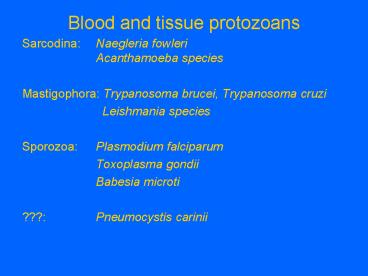Blood and tissue protozoans - PowerPoint PPT Presentation
1 / 10
Title:
Blood and tissue protozoans
Description:
Free-living implies lack of necessity for a host organism, but this ... He is also ubiquitous in fresh waters, but can also be found in brackish and salt water. ... – PowerPoint PPT presentation
Number of Views:734
Avg rating:3.0/5.0
Title: Blood and tissue protozoans
1
Blood and tissue protozoans
- Sarcodina Naegleria fowleri
Acanthamoeba species - Mastigophora Trypanosoma brucei, Trypanosoma
cruzi - Leishmania species
- Sporozoa Plasmodium falciparum
- Toxoplasma gondii
- Babesia microti
- ??? Pneumocystis carinii
2
Focus on pathogens Naegleria fowleri
- Facts / life-cycle N. fowleri is a free-living
protozoan in the phylum Sarcodina. Free-living
implies lack of necessity for a host organism,
but this guy can be a pathogen. He has no need
for a 2 host. Trophs multiply by simple binary
fission, can form cysts, but can also form a
flagellated form (?) incapable of reproduction.
N. fowleri lives in warm fresh water and soil
where he usually comes in contact with human
hosts in lakes, rivers, swimming pools,
whirlpools jacuzzis although cases have also
been linked to cysts in dust, and to air
conditioning units. Cysts are moderately
chlorine resistant adding to the problem.
3
(No Transcript)
4
Focus on pathogens Naegleria fowleri
- Epidemiology the organism is common in warm
fresh waters worldwide, so exposure to humans is
common. Although clusters of localized
infections occur, there seems to be no
correlation between areas of greatest parasite
abundance ie. infection rates are not higher in
equatorial warm waters as would be expected.
Most patients have been in a swimming pool or
natural fresh water a few days prior to symptom
onset. Infections, at least those causing
disease are rare, but disease causing infections
have a high mortality rate. Of 150 reported
cases, only 3 patients have survived. Most of
the patients have been children and young adults.
5
Focus on pathogens Naegleria fowleri
- Pathology / clinical symptoms N. fowleri causes
a condition known as primary amoebic
meningoencephalitis, a fulminating, rapidly fatal
disease. The amoebas enter the brain via the
olfactory epithelium. The disease appears with
the sudden onset of bifrontal or bitemporal
headache, fever, nausea, vomiting, and stiff
neck. The affected areas fo the brain are
necrotic and hemorhagic. Purulence from immune
response results in rapidly escalating
intracranial pressure. Symptoms progress rapidly
to lethargy, confusion, and coma. In all of the
recorded cases, the patient died within 48 to 72
hours.
6
N. fowleri laboratory diagnosis
- Trophs
- Size 7-20uM
- Single nucleus with large karyosome and no
peripheral chromatin - Clear halo nuclear halo often visible
- Motility very active with single or multiple
broad blunt pseudopods - Trophs convert to flagellated form within a few
minutes after being exposed to clear distilled
water - Cyst round, with size and nuclear
characteristics identical to troph. Cysts of
this organism are rarely found in clinical
specimens.
7
(No Transcript)
8
Focus on pathogens Acanthamoeba
- Facts / life-cycle this is also a free-living
amoeba. Several species of the Genus are human
pathogens, and no attempt is made to distinguish
them. His life cycle is similar to Naegleria
except for the absence of the flagellated form.
He is also ubiquitous in fresh waters, but can
also be found in brackish and salt water.
Transmission appears to be similar to Naegleria
with added means by entry through the skin. Once
established in the patient, Acanthamoeba can
spread via the circulatory system to cause
pathology in other tissues, namely eyes,
integument and lungs.
9
Focus on pathogens Acanthamoeba
- Epidemiology Similar to N. fowleri. It is
found in the same places, and is transmitted in
the same way, although it is more common. There
are 1000 cases annually of granulomatous amoebic
encephalitis and amoebic keratitis caused by
Acanthmoeba species. Pathology of other tissues,
including integument and lungs does occur, but
are rare.
10
Focus on pathogens Acanthamoeba
- Pathology / clinical symptoms unlike N.
fowleri, Acanthamoeba infection is usually
limited to chronically ill, immunocompromised or
otherwise debilitated patients. Two types of
clinical syndromes are involved. Granulomatous
amoebic encephalitis (GAE), similar to the neural
condition caused by N. fowleri, is more slowly
progressing and chronic, but also has a high
mortality rate, partly due to the poor condition
of the host. AIDS patients comprise a large
percentage of GAE patients. - The second common syndrome is amoebic keratitis,
a blinding inflamatory condition of the cornea.
Contact lens use predisposes folks to this
condition. - Acanthamoeba species can also cause opportunistic
lung and skin infections in immunocompromised
patients.































